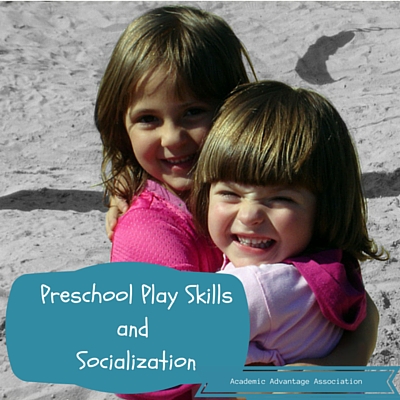It’s the word all homeschooling moms dread to hear: socialization. There are many reasons for understanding the stages of preschool play and socialization.
1) When you know the stages children move through as they develop social skills, you may feel more prepared to answer those hot button questions about <gasp> ‘socialization’.
2) Understanding the normal progression of play skills may help you recognize delays in development.
3) Understanding the way children play will help you make wiser choices about how to plan early learning activities.
Children move through four stages of play skills between the ages of birth and five.
a) Solitary – From infancy through to around age two, children play without interacting with others in pre-planned ways. They may laugh when ‘playing’ peek-a-boo with you and indicate a desire for more. Eventually, they learn if they drop an object, you will pick it up.
Think of play at this age as one experiment after another as they attain new skills and make draw conclusions about each new experience compared with others.
They are interacting with the world around them without the back and forth older children have matured into. Play starts when they discover their own hands and feet, toys in the crib around them, or hanging from a car seat handle.
During this part of the learning process, they learn some things (and people) are predictable and some are not.
If your baby and young toddler snatches a toy from another, you are seeing the influence of solitary play skills in action. Rather than label the behavior as bad and react in a panic, simply move your little’s attention to another ‘shinier’ object, and the uproar will quickly be over.
While short attention spans may plague you as your children mature, this season is one to rejoice at how easily distracted they are!
Parallel – Children begin to play ‘in parallel’ around age two. Given the attention to play dates and play groups, you might think age two is about the time children begin to cooperate with other children to ‘play nicely’.
Understanding their limitations in this regard will save you and other moms and children some heart breaking moments of misunderstanding. At this age children enjoy sitting close to one another while playing. They watch, learn, and listen from one another. They want their own things and space, however, and are not ready to ‘share’.
In this parallel stage, everything within reach, maybe even across the room, is ‘personal property’. Your toddler may howl when another child picks up a toy they want.
They are beginning to learn about the concept of ‘sharing’ when they have to relinquish a toy. Sharing won’t be easy yet because of they are still in parallel play mode. Again, their easy distractibility at this age is your ally, so use it!
Associative – Closer to age three and four, children begin to look as though they are playing together when, in fact, they are following one another’s lead. One may build with blocks and another come along side and begin to build. They may talk back and forth, share blocks, and answer questions each ask the other. But, they will build independently of the other v.s. working on building something together.
Cooperative – Between ages four and five, children have usually learned the listening and communication skills to enter into cooperative play. You will note they are able to develop a strategy to pretend and work together on that imaginary scene under way. This is also the time when children begin to be able to work together to play games – even if they make up their own rules!
You’ll hear conversation revolve around who is playing what role or what should happen next in the joint venture. While there still may be squabbles over who will use what playthings, you will also see some skirmishes over who is playing what role in the game afoot.
Understanding the stages of play will help you in planning learning activities. Toddlers will enjoy independent activities that do not require sharing materials like early learning puzzles. K5’ers can work together to play dress up and will enjoy costumes that allow them to try on roles of community helpers.
Knowing what to expect from your child when you are trying to foster social skills will keep you and your child from feeling frustrated and uncertain.

